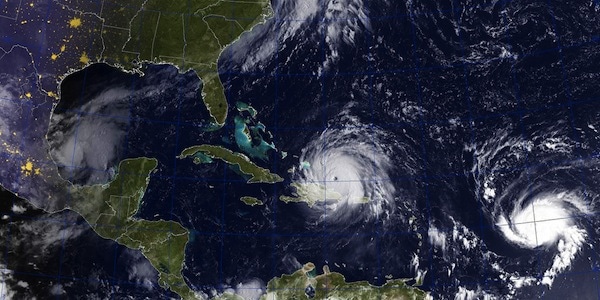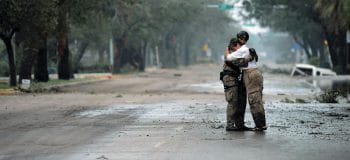We’ve witnessed the destruction done by Hurricane Harvey and now, less than two weeks later, with clean-up in Texas and Louisiana scarcely underway, we see the path of Caribbean devastation Hurricane Irma is leaving as it heads toward mainland U.S. The NHC is warning that Irma will bring dangerous storm surge to coastal Florida, and heavy rain and life-threatening flooding from Florida to North Carolina.
With preparedness efforts being marshalled to the Southeast U.S. and specific risks coming into better focus, we offer a composite of what our team – experts at the intersection of science, policy, and social equity – is seeing.
The science snapshot: a punishing hurricane season
Lead author: Astrid Caldas, Senior Climate Scientist.
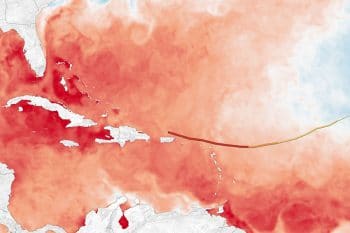
As Hurricane Irma approaches Florida, it will pass over extremely warm water that could provide fuel for an already strong storm.
What conditions are fueling a punishing hurricane season?
We’re in the midst of a terrifying storm season. Back on May 25, The National Hurricane Center released its annual Atlantic Hurricane Season Outlook for 2017, which predicted a 45 percent chance of an above-normal season. On August 9 an update was published that forecast a more active season than previously predicted, with a 60 percent chance of an above-normal season. One of the reasons behind the update: warm ocean water temperatures.
Oceans have absorbed about 93 percent of global warming to date, and all that warmth can intensify hurricanes and increase the amount of rain they deliver (see here). During the northern hemisphere’s warm months, sea surface temperatures rise, creating that unique hurricane fuel. And we are certainly seeing the forecast materialize with two (likely three) back-to-back major hurricanes.
Harvey underwent a very rapid strengthening from tropical storm to category 4 hurricane, moving over waters that were 2.7-7.2°F above average. The record rain it brought – over 50 inches in places – made the National Weather Service create new colors for their precipitation maps to show the unprecedented amounts. Irma quickly became a category 5 hurricane earlier this week, feeding off abnormally warm waters along its path across the northeast Caribbean. Its 180+ mph winds held for the longest time of any storm and set a record for an Atlantic hurricane – the strongest ever recorded. And according to NOAA, the sea surface temperature where Irma was located on as it thrashed Puerto Rico is “hot enough to sustain a category 5 storm.”
If Irma strikes the U.S. coast as a Category 4 storm, it will be the first time in over a century that an Atlantic hurricane season produced two storms of that strength that made landfall on the U.S. mainland.
The policy picture: Harvey requires staggering resources — Irma will too
Lead Authors: Rachel Cleetus, Lead Economist and Climate Policy Manager, and Shana Udvarvy, Climate Preparedness Specialist.
Major disasters like Harvey and Irma call for robust federal leadership and significant resources. Recent news reports indicate that FEMA, the lead federal agency involved in disaster response, is running alarmingly low on funding in the wake of a spate of recent disasters. With the damaging impacts of Irma (and potentially Jose and/or the next storm, as well as other disasters such as the current wildfires in the West) adding up, Congress needs to act quickly to ensure the agency has adequate resources to help protect communities and aid in their recovery.
And it’s not just FEMA—HUD, USACE, EPA and DOT are among the many federal agencies that work in close coordination with state and local authorities to get people back on their feet safely and ensure the repair and rebuilding of critical infrastructure. They too need to be well funded right now.
An important way to limit harms to people and the economy is to invest in preparedness well ahead of a disaster, which is why the Trump administration’s attempts to cut the budgets of agencies like FEMA , HUD, NOAA and NASA and the President’s Executive Order rolling back the federal flood risk management standards earlier this year were so short-sighted and frankly dangerous. (No, Secretary Ben Carson, HUD cannot deliver on its mission properly while understaffed and with the $6 billion cut in its budget that President Trump had proposed.)
Even as Congress works to provide immediate disaster relief for those who are suffering the impacts of Harvey, Irma and other disasters, it’s vital that they look ahead to provide the resources and policies we need to help protect people from future catastrophes.
Our colleague Rob points out five things Congress should do right away. And we’ll add a sixth: It’s high time for Congress and the administration to stop denying basic scientific facts about climate change and its worsening impacts on Americans and work together on solutions that will help protect us.
Profile of the next storm: How Irma is different from Harvey
Lead Author: Kristy Dahl, Climate Scientist.
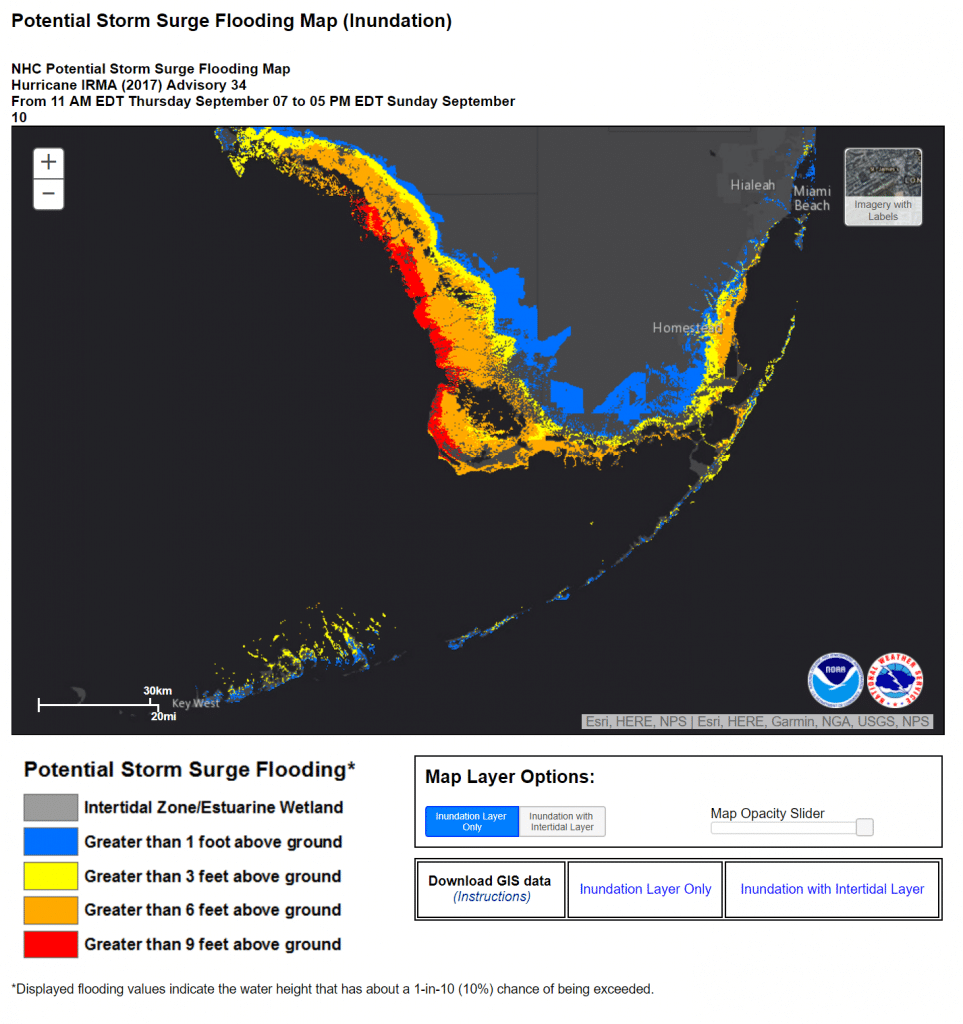 Irma is record-breaking in ways that are distinct from Harvey, and, depending on its path, has the potential to bring catastrophic storm surge to southeastern coastal states. The National Weather Service has already issued storm surge watches for both coasts of Florida south of Cape Coral and West Palm Beach and initial storm surge estimates exceed 9 feet in parts of the Everglades.
Irma is record-breaking in ways that are distinct from Harvey, and, depending on its path, has the potential to bring catastrophic storm surge to southeastern coastal states. The National Weather Service has already issued storm surge watches for both coasts of Florida south of Cape Coral and West Palm Beach and initial storm surge estimates exceed 9 feet in parts of the Everglades.
As Jeff Masters, of Weather Underground, points out, though, the northern coast of Florida, Georgia, and southern South Carolina, because of its concave shape, could experience much larger storm surges. Based on modeling of hypothetical storms (i.e., not specifically Irma), a Category 3 storm could cause 17 to 23 feet of storm surge along the northern Florida and Georgia coasts. That would put Irma into Katrina’s league.
In addition, Irma’s winds and waves could greatly impact coastal areas. If Irma approaches Florida as a Category 4 storm, its sustained winds could range from 130-156 mph, though gusts could be higher. And because the relatively deep water off the coast of Miami allows large waves to develop, the coastline could experience heavy wave damage.
Residents in these states should monitor NWS’s potential storm surge flooding maps and heed local warnings.
A picture of mobilization, with Harvey’s victims to thank
Lead Author: Erika Spanger-Siegfried, Senior Analyst in the Climate and Energy Program.
While it raged over Texas and later Louisiana, Hurricane Harvey brought much of the region and the nation’s 4th largest city to their knees, displacing over a million people and leaving more than 300,000 without power. The slow-moving catastrophe gripped the nation. Rooftop calls for rescue were answered, with stories of heroism and care emerging; and others went unanswered for days, while suffering deepened. We are shaken. Another Katrina, some say.
So when a new storm so quickly formed into Irma in the tropical Atlantic, we are meeting it with vastly heightened concern. Not the anxiety that we can whip ourselves into over, e.g., a heavy snow forecast, but with open-eyed, informed, rational dread.
Irma utterly devastated several Caribbean islands, destroying 90 percent of Barbuda’s buildings and leaving half of its population homeless, according to its prime minister. Next it is going to turn north and head toward Florida and the Southeast U.S. with potentially catastrophic impacts. Whatever specific path it follows, it is big enough to impact the entire state of Florida.
The risks aren’t lost on Southeast officials and the response in these states has been swift and serious. Orders will change by the time you read this, but as early as Monday, September 4th, Florida Governor Rick Scott had declared a state of emergency, and by Thursday, the governors of Georgia, South Carolina and North Carolina had as well. As of Thursday afternoon, mandatory local evacuations orders had been issued from the Florida Keys, through locations like Savannah, Georgia. All 7,000 members of Florida’s National Guard and Guard from other states were being mobilized and FEMA staff were mobilizing teams and resources.
Harvey, as the first major storm of the season, provided a service by shaping and elevating the level of concern across the nation. The attention focused by Harvey on the very real threat of the 2017 hurricane season hopefully means that more people in the coastal southeast will have retreated to safety when Irma strikes. Thank you, Texas, for your sacrifice.
Snapshot of a State: This is Not Hurricane Andrew’s Florida
Lead Authors: Erika Spanger-Siegfried, Senior Analyst in the Climate and Energy Program, Kristy Dahl, Climate Scientist, Edwin Lyman, Senior Scientist, Global Security Program, and Steve Clemmer, Director of Energy Research and Analysis.
Much has changed in the 25 years since Hurricane Andrew struck Florida. Like Houston, which added more than 800,000 new metro area residents since 2010, South Florida’s population has grown rapidly in recent decades. Many are new residents or have been born after 1992, therefore don’t have the frame of reference of the danger a major hurricane can bring.
Miami-Dade County grew nearly 8 percent in just the last 5 years, to 2.7 million. But it is distinct from other urban areas in the millions of residents who are clustered so close to a coast that is, in turn, so close to sea level. Where there are people, there is housing — about 43,000 condos have been built in the last 15 years just in the strip of Miami-Dade County between I-95 and the Atlantic.
And there is infrastructure to support them. Our just-released map of energy and industrial infrastructure exposed to Harvey flooding illustrates how vast the public health, environmental and economic risks of hurricane-impacted infrastructure can be.
UCS’s 2015 Lights Out? analysis showed that storm surge from a Category 3 hurricane could expose nearly 40 electrical substations in Miami and southeastern Florida to flooding. Widespread and long-lasting power outages can occur when only a few pieces of critical electrical infrastructure are damaged, as we have seen happen from Hurricanes Harvey, Sandy, Katrina and Rita. A stronger storm, along with high winds and heavy rainfall, could add to this flooding risk and cause significant damage to more substations and other electricity infrastructure, including power lines and power plants located in the area. The resulting potential for prolonged outages could present grave dangers for critical infrastructure dependent on reliable electricity supply, like hospitals, police and fire departments, and communication networks
Despite the claims of Governor Rick Scott and FP&L, Irma could pose a threat to Florida’s two nuclear plants, Turkey Point and St. Lucie. Even after the plants are shut down in advance of the storm, the fuel in the cores of the reactors and the spent nuclear fuel in storage pools are hot and highly radioactive and must be continuously cooled to prevent them from overheating and melting.
The March 2011 Fukushima nuclear plant disaster in Japan occurred because massive flooding of the reactor site disabled on-site backup power supplies and shorted out electrical distribution systems. After Fukushima, the U.S. Nuclear Regulatory Commission ordered nuclear plants to take measures to reevaluate their vulnerabilities to natural disasters, and most plants in the U.S. found that they were subject to floods more severe than those they were originally designed to withstand. Florida’s nuclear plants were no exception. But the industry’s response to this new information has been too slow. Even today, more than six years after Fukushima, nuclear plant owners have not fully implemented measures to mitigate the new threats, and vulnerabilities will remain even after they are in place.
Looking at the region more broadly, the coastline between Key West, Florida, and Beaufort, South Carolina, is home to more than a dozen military installations, many of which could see more than 50 per cent of their area flood with a Category 3 storm.
The big picture: People, once again, in the jaws of a storm
Lead Authors: Nicole Hernandez-Hammer, Climate Scientist and Community Advocate, Rachel Cleetus, Lead Economist and Climate Policy Manager.
 While thousands of people are already evacuating Florida, getting out of harm’s way can often be easier said than done. The Miami native on our team is hearing from folks on the ground that people are trying to find lodging out of reach of the storm but many places within a day’s drive are already booked. Many are staying with family or finding hotels further out of state. People are being forced to make tough decisions about when to leave and what to take along, how to safely evacuate children, the elderly, the sick or others who may be vulnerable. Of Miami’s emergency shelters, only one currently allows pets. And we’re hearing from people who want to leave but can’t: they don’t have cars and were told the Greyhound buses are full. They are forced to remain and ride out the storm.
While thousands of people are already evacuating Florida, getting out of harm’s way can often be easier said than done. The Miami native on our team is hearing from folks on the ground that people are trying to find lodging out of reach of the storm but many places within a day’s drive are already booked. Many are staying with family or finding hotels further out of state. People are being forced to make tough decisions about when to leave and what to take along, how to safely evacuate children, the elderly, the sick or others who may be vulnerable. Of Miami’s emergency shelters, only one currently allows pets. And we’re hearing from people who want to leave but can’t: they don’t have cars and were told the Greyhound buses are full. They are forced to remain and ride out the storm.
Evacuating also means leaving work, which is especially hard for those who live paycheck to paycheck – can they get the time off and if so, can they afford it? Some businesses like grocery stores and banks want to stay open to provide supplies for storm preparation, which helps those remaining and hinders their workers wishing to leave. Day laborers and hourly-wage earners can feel the pressure to make as much money as possible in advance of the storm so they can afford either to evacuate or supplies to shelter in place. All the while South Floridians are dealing with the uncertainty of whether they’ll have a job, a home even, after the storm passes.
In this moment, undocumented immigrants face compounded fears about seeking shelter and relying on federal authorities for help. News reports indicate that these fears are affecting immigrant communities in Houston. South Florida is home to approximately 450,000 undocumented immigrants who may be facing the same fears. FEMA has tried to allay concerns about ID checks by immigration officials at shelters but understandably many have serious misgivings with an administration that so recently made a decision to end the DACA program, has tried to withhold funding from sanctuary cities, and has frequently employed blatantly racist and xenophobic rhetoric. These politics are an obstacle to people finding safety, and a disgrace.
In addition, our research and research from others show that disasters like these have a disproportionate impact on disadvantaged communities and communities of color. As an example, in a recent report we highlighted the plight of Opa-Locka and Hialeah, two low-income communities in the western edge of Miami-Dade County, that have struggled for decades with the impacts of storms and flooding.
As with Harvey, ordinary people are rising to the occasion and doing their best to prepare for Irma. A grassroots effort to help with storm preparations is being coordinated by the Miami Climate Alliance, the CLEO Institute and the New Florida Majority, and an informal emergency operations center has sprung up in Miami-Dade and Broward counties to help low income, disabled and elderly people.
How to move forward? Building a legacy of hard-won lessons
Lead Authors:Erika Spanger-Siegfried, Senior Analyst in the Climate and Energy Program and Rachel Cleetus, Lead Economist and Climate Policy Manager.
The devastating hurricanes we endure as a nation, as states, as communities — we have learned something profoundly important from each. From Andrew, we witnessed the painful pace of disaster recovery and learned how to better manage such processes and how to build stronger. In Katrina, we encountered our own hubris in the feebleness of our man-made defenses and in how many lives we had put at risk. With Sandy, we acknowledged the role of climate change and started learning to build and rebuild for a climate change future. And through all these storms, we’ve witnessed the injustices that some communities—particularly those that are economically and politically disempowered— have faced, where recovery has come much more slowly, if at all.
With Harvey and Irma, there will be smaller lessons – like, we knew the way we were planning, developing, and building was creating risk, and we kept doing it anyway. And there will be big lessons too. Not only have we built unnecessary risk into our built environment, we’ve added risk to our very environment with climate change exacerbating the threat each time hurricane season arrives, and there is no putting this angry genie back in the bottle.
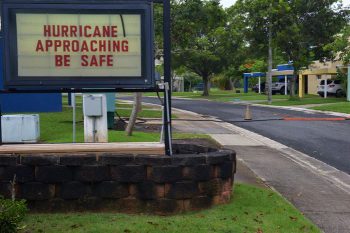
A safety message on the base housing marquee sign reminds residents of the coming Hurricane Irma at Coast Guard Sector San Juan, Puerto Rico, Sept. 6, 2017. U.S. Coast Guard photo by Petty Officer 2nd Class Jonathan Lally.
In this moment between these massive storms, when we would each eagerly wish away a world where such fearsome scenarios are possible and so many people are under threat, we’ll instead need to face, not just the next storm, but the new reality. When these storms finally pass and people are safe, we’ll need to take stock with wiser eyes.
First, we’ll need to remember that recovery efforts will take time and need money. Long after these storms drop out of the headlines, we’ve got to ensure policymakers are focused on the needs of affected communities. And we’ll need to demand better of our leaders, whose failings look particularly stark right now. If you’re not helping to turn the tide toward a more resilient future, you’re not a leader for our times.
In the meantime, our focus remains on our brothers and sisters in the path of the storm. If you can donate, UCS recommends donations to local groups working on hurricane response and on longer-term climate education and preparedness, such as the Miami Climate Alliance and the CLEO Institute, in addition to large groups like the Red Cross or Direct Relief.

